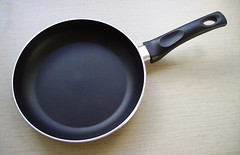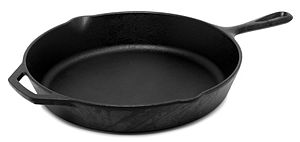Canaries kept as home pets have been known to die from toxic gases released from heated Teflon/non-stick cookware. Could we conclude, like the miners, that air so polluted is not safe for humans? For that matter, what about the chemicals in Teflon - can they leach into food?
| Teflon frying pan (Photo credit: JPC24M) |
There is usually an "if" to claims that non-stick cookware is safe: Teflon is safe if it is not damaged, if it is not heated to too high a temperature, and if the cookware is not heated when dry or empty.
According to the United States Environmental Protection Agency (epa.gov), PFOA is persistent in the environment and in the human body - in other words, it does not break down (meaning it stays a part of your overall toxic load).
Potentially carcinogenic, PFOA is implicated in cancer, particularly breast cancer, and can cause birth defects in laboratory animals. Known variously as "polymer fever," "Teflon flu," or "Teflon toxicosis," a flu-like condition can result from the inhalation of fumes released from heated Teflon. Such risks are even greater if the non-stick surface of the cookware is scratched or otherwise damaged.
So What Are Some Safer Alternatives?
-Stainless steel
A combination of various metals, including nickel and chromium, stainless steel is generally considered safe as long as it is not pitted, dented, or otherwise damaged. If it is damaged, its various metallic components can leach into foods.
| A cast-iron skillet. (Photo credit: Wikipedia) |
When properly seasoned, cast iron is safe and can actually enhance health. The iron that leaches into the food is usually a healthy additive. Your family will probably not need to take iron supplements if you use cast iron cookware! (Note: Cast iron must be properly maintained - see our post here on taking care of your cast iron cookware.)
-Aluminum
Aluminum cookware has inconclusively been implicated in Alzheimer's disease. What is known about aluminum is that high-acid foods leach a significant amount of the metal into the food, and scratched or damaged aluminum cookware leaches more. Use with caution.
-Anodized aluminum
This is a form of aluminum that has been specially treated with acid to create a harder version that does not leach into foods. Anodized aluminum seems to be quite safe, and is generally affordable.
-Ceramic/Enamelware
Enamelware delivers the even heating of cast iron without concern with proper seasoning. Enamelware is iron cookware that has been coated with enamel (a kind of glass).
-Copper
Large amounts of copper can leach into foods, but copperware lined with stainless steel or tin is a safer alternative.
With a little research, it is not too difficult to find a safe cookware that will fit your family's needs and budget. Even if you're still on the fence about whether Teflon is all that unsafe, why take the risk, when there are plenty of other safer options out there?



No comments:
Post a Comment